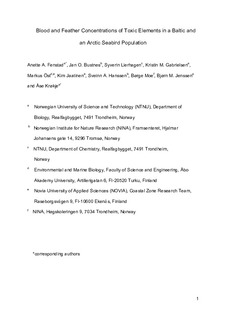| dc.contributor.author | Fenstad, Anette | |
| dc.contributor.author | Bustnes, Jan Ove | |
| dc.contributor.author | Lierhagen, Syverin | |
| dc.contributor.author | Gabrielsen, Kristin Møller | |
| dc.contributor.author | Öst, Markus | |
| dc.contributor.author | Jaatinen, Kim | |
| dc.contributor.author | Hanssen, Sveinn Are | |
| dc.contributor.author | Moe, Børge | |
| dc.contributor.author | Jenssen, Bjørn Munro | |
| dc.contributor.author | Krøkje, Åse | |
| dc.date.accessioned | 2017-12-07T12:28:03Z | |
| dc.date.available | 2017-12-07T12:28:03Z | |
| dc.date.created | 2016-11-02T14:12:37Z | |
| dc.date.issued | 2017 | |
| dc.identifier.citation | Marine Pollution Bulletin. 2017, 114 (2), 1152-1158. | nb_NO |
| dc.identifier.issn | 0025-326X | |
| dc.identifier.uri | http://hdl.handle.net/11250/2469553 | |
| dc.description.abstract | Wereport blood and feather concentrations of elements in the Baltic Sea and Arctic population of common eiders (Somateria mollissima). The endangered Baltic Sea population of eiders was demonstrably affected by element pollution in the 1990s. While blood concentrations of Hg were higher in Baltic breeding eiders, blood Se, As and Cd concentrations were higher in Arctic eiders. Blood concentrations of Pb, Cr, Zn and Cu did not differ between the two populations. While blood Pb concentrations had declined in Baltic eiders since the 1990s, Hg concentrations had not declined, and were above concentrations associated with adverse oxidative effects in other bird species. Inconsistent with blood concentrations, feather concentrations suggested that Pb, Zn, and Cd exposure was higher in Baltic eiders, and that Hg exposure was higher in Arctic eiders. Our study thus emphasizes the need for comprehensive evaluation of toxic element status, covering the annual cycle of a species. © 2016 Elsevier Ltd. All rights reserved. Common eiders Heavy metals Pollution Environmental exposure Svalbard | nb_NO |
| dc.language.iso | eng | nb_NO |
| dc.publisher | Elsevier | nb_NO |
| dc.rights | Attribution-NonCommercial-NoDerivatives 4.0 Internasjonal | * |
| dc.rights.uri | http://creativecommons.org/licenses/by-nc-nd/4.0/deed.no | * |
| dc.title | Blood and feather concentrations of toxic elements in a Baltic and an Arctic seabird population | nb_NO |
| dc.type | Journal article | nb_NO |
| dc.type | Peer reviewed | nb_NO |
| dc.description.version | publishedVersion | nb_NO |
| dc.source.pagenumber | 1152-1158 | nb_NO |
| dc.source.volume | 114 | nb_NO |
| dc.source.journal | Marine Pollution Bulletin | nb_NO |
| dc.source.issue | 2 | nb_NO |
| dc.identifier.doi | 10.1016/j.marpolbul.2016.10.034 | |
| dc.identifier.cristin | 1396645 | |
| dc.description.localcode | © 2016. This is the authors’ accepted and refereed manuscript to the article. LOCKED until 23.10.2018 due to copyright restrictions. This manuscript version is made available under the CC-BY-NC-ND 4.0 license http://creativecommons.org/licenses/by-nc-nd/4.0/ | nb_NO |
| cristin.unitcode | 194,66,10,0 | |
| cristin.unitcode | 194,66,25,0 | |
| cristin.unitname | Institutt for biologi | |
| cristin.unitname | Institutt for kjemi | |
| cristin.ispublished | true | |
| cristin.fulltext | original | |
| cristin.qualitycode | 1 | |

